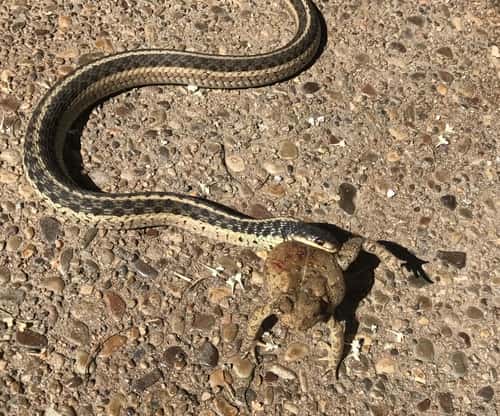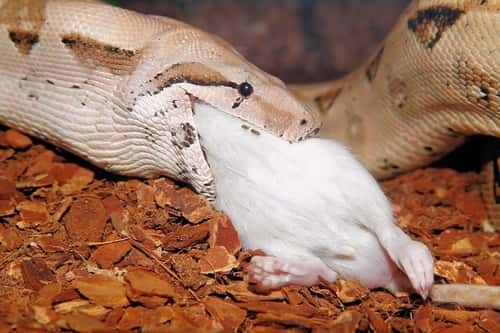
A lot of people like to handle their pet snakes. But it gets tricky when you have recently fed them. As many snake owners don’t know how long it takes snakes to digest their food. And how much time should be given to the snake after feeding, to handle them? To make it easy to understand, I have made a complete analysis. And here is what you need to know.
How long does it take snakes to digest their food? An adult pet snake takes nearly 72 to 120 hours to digest its food. However, the time taken for the digestion can vary based on their age, species, temperature, and size of the prey they eat. As snakes have a slow metabolism and they swallow their prey whole. It takes significantly more time to fully digest their food.
Many factors play a vital role in the process of digestion. There is no precise time period that snakes take to digest their food.
A large snake such as a python can take nearly 5-9 days to complete the digestion cycle, from feeding to excreting feces.
Whereas some constrictor species of snake could complete the same process in a time period of 24-48 hours.
Other than this factor like temperature also plays a dominant role in the process of digestion.
Snakes need a warm temperature between 28 °C to 32 °C (82 °F to 90 °F ) to digest their food and regulate other body functions properly.
To make it easier for you I have listed the most popular species of pet snakes according to their age and the time it takes them to digest a rodent.
How long does it take for a snake to digest a mouse?
With a suitable temperature for Digestion, a baby snake takes nearly 24- 48 hours to digest a mouse of a size equal to the thickest part of the snake’s body. Whereas an adult snake tends to eat larger mice, so it takes nearly 5 to 7 days to complete the process of digestion.
However, the time period that I have mentioned is not the ultimate answer to the question as the digestion process also relies on the age and species of the snake.
For example, Species like garter snakes are very active, and with a fast metabolism, they tend to digest their food quickly. Thus they can complete the process of digestion in 24-36 hours.
On the other side snakes that are ambush predators, like ball pythons; have a low metabolism, and they remain inactive for most of the time. Thus it takes them 4 to 7 days to digest their food properly.
Snakes like ball pythons tend to hold their food in their body for a longer period of time and digest their food slowly to minimize the consumption of energy.
To better understand this I have listed down the most popular breeds of snakes and the time they take to digest a mouse.
| Snake Species | Avg. Time to Digest Food |
|---|---|
| Young Ball python | 2 to 3 days |
| Adult Ball python | 5 to 9 days |
| Young corn snake | 1 to 2 days |
| Adult corn snake | 4 to 5 days |
| Young Garter snake | 1 to 2 days |
| Adult Garter snake | 2 to 3 days |
| Young Hognose snake | 24 to 36 hours |
| Adult Hognose snake | 3 to 4 days |
| Young Kingsnake | 2 to 3 days |
| Adult Kingsnake | 4 to 7 days |
It turns out that young snakes need lesser time to digest their food as compare to adult snakes. As young snake quickly gain substantial mass and size.
They need more energy in growth and development. Due to this their digestion cycle is much shorter as compared to adult snakes.
Similarly, species of snakes that are quite smaller in size also have a short digestion cycle. Because such species of snakes do not accumulate any extra body mass and they also tend to have a very active life cycle.
This must have triggered a question in your mind that’s why it takes so long for a snake to digest its food. Keep reading further as I have covered the reason behind the long time interval of digestion.
Why does a snake take so long to digest?

As snakes do not have any special sets of teeth to shred their prey, they need to swallow their prey in whole, due to which the digestive enzymes in a snake’s body need excess time to break down the food compound for proper digestion this contributes to the prolonged digestion in snakes.
Other than this the metabolism of snakes plays a key role in the process of digestion. As snakes are the cold-blooded animal that means they body muscle act much slower in processing food.
Apart from this other factors such as their body temperature, species of the snake, age, size of the prey they eat and gender plays an important role in the process of digestion. Below I have explained the factors that affect the process of digestion.
Factors that affect the process of digestion
Temperature
Most of the energy required by snakes to perform all the body functions from digestion to respiration and circulation of blood in their body. Requires an adequate amount of heat energy. Snakes rely on external sources of heat to carry out these functions.
A sudden fluctuation in the external temperature can highly influence the digestion process of the snakes.
A sufficient source of heat providing a temperature ranging from 28 °C to 32 °C must be given to your pet snake in order to accelerate the process of digestion.
If the temperature dips below 28 °C then the snake can take a longer period of time in digesting or it can even expel the food.
Low temperature can even result in fasting in many species of snakes.
Species
The time period for the digestion process extensively differs from species to species in snakes. As some species of snakes, like garter snakes, actively forage for food thus they have to burn more energy as compared to snakes like ball pythons, which are ambush predators.
As these species burn more energy to hunt for their food their metabolism is more rapid and hence they require to eat more frequently which results in a shorter digestion period.
While on the other side snakes species that are ambush predators wait for their prey to cross their path. Thus they preserve a lot of energy which is required in foraging for prey by remains inactive for most of the time.
Age
While Snakes are in their growth phase they constantly undergo the process of shedding and developing new skin frequently.
Their body requires more essential nutrients to support this rapid growth due to which snake hatchling or their young ones consumes more food with a short cycle of digestion.
Other than this the young snakes lean on small prey that doesn’t take a lot of time for digestion. While on the other side a full-grown adult snake consumes large prey which needs an adequate amount of time for digestion.
After attaining a certain age the metabolic rate of snakes slows down. That results in a slow down in their digestion process.
Size of the Prey
This is one of the most important things that play a huge role in the time duration of the digestion process of snakes.
As you know that snakes do not have any special sets of teeth to chew their prey. Thus they need to swallow the prey whole at once. This process of eating significantly affects the process of digestion.
As the prey is swallowed whole, the digestive enzyme in the guts of snakes has to digest the prey right from the outer skin and continuing till bones. While chewing and shedding make the digestion process much faster in other creatures.
But in snakes, the digestion of whole prey significantly increases the time period as the stomach acid acquires a lesser surface area of the prey, the dissolving and breaking down of proteins, and other mineral resources take more time.
The time taken for digestion is directly proportional to the size of the prey a snake eats. The bigger the prey the more time it takes for digestion.
Gender
In general, gender doesn’t make much of a difference in the digestion period of snakes. But it starts to differ when a female Snake proceeds toward breeding.
As the process of breeding is an energy-intensive work the female snakes require more frequent meals than usual.
During this period their metabolic rate shoots up and the digestion process becomes much shorter. However, the snake’s body comes to normal after the eggs are laid.
Can snakes digest everything they eat?

Snakes are not capable of digesting everything they eat. Because, organs like large bones, nails, teeth, fur, and feathers of the prey are either too large to digest or are made of keratin, which cannot be broken down by the enzymes and acid present in the gut of snakes.
So why do snakes swallow their prey whole at once? If they are not able to digest everything they eat. Well, the answer is simple, they are not stocked with any other options, other than swallowing their prey whole.
As snakes don’t have any special set of teeth to chew on their food. The only option they are left with is to swallow the prey in whole. But swallowing the whole prey seems to be a good idea. Because snakes get all types of essential nutrients like calcium, protein, carbs, and other fatty acids from consuming the whole prey.
The gastric acid present in the snake’s body is strong enough to dissolve flesh, small bones, and other organs of the prey. However, the time taken for digestion is comparatively high as the acid present in the body of the snake requires time to break down the calcium of bones.
Related question
How long does it take for a ball python to digest?
An adult ball python takes five to nine days to completely digest its food. While the ball python hatchling can take 2 to 3 days to complete the process of digestion. The time period of digestion varies according to the temperature and the size of the prey.
How long does it take for a corn snake to digest?
Under the right set of conditions, a baby corn snake can take 24 to 48 hours to complete the digestion process. While adult corn snakes can take 4 to 5 days to complete the digestion process. The digestion can take longer if the temperature is low or if the prey is large in size.
